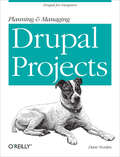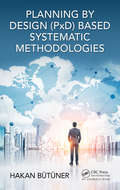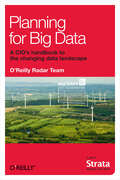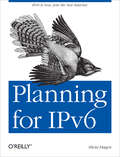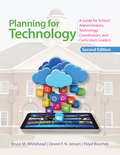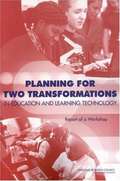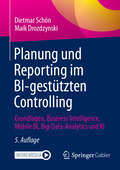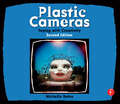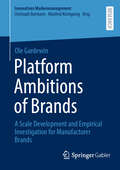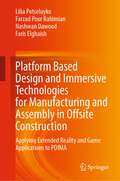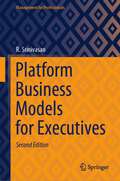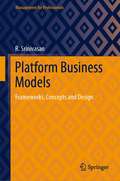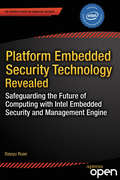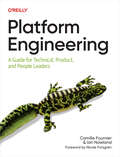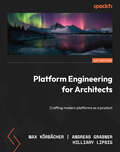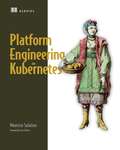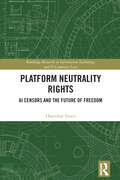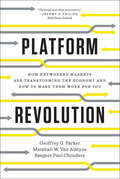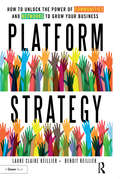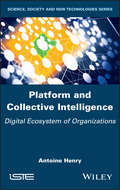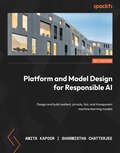- Table View
- List View
Planning and Managing Drupal Projects: Drupal for Designers (Oreilly And Associate Ser.)
by Dani NordinIf you're a solo website designer or part of a small team itching to build interesting projects with Drupal, this concise guide will get you started. Drupal’s learning curve has thrown off many experienced designers, particularly the way it handles design challenges. This book shows you the lifecycle of a typical Drupal project, with emphasis on the early stages of site planning. Learn how to efficiently estimate and set up your own project, so you can focus on ways to make your vision a reality, rather than let project management details constantly distract you.Plan and estimate your project by discovering your client’s goals and audience perceptionsDiscover how Drupal works under the hood, and learn basic DrupalSpeakFrame the UX design challenge through a deeper understanding of your site’s intended usersGet real content for your project as early as possible—before you start prototypingChoose the right modules for your project, and learn about several go-to modulesUnderstand how to walk clients through the Drupal design and development process
Planning by Design (PxD)-Based Systematic Methodologies
by Hakan ButunerThe book shows how to use Planning by Design (PxD) for developing working models to any type of subject area. Section 1 describes the nature of planning in general, the formula of planning, the features that make it systematic, the essence of PxD, and developing and using the working model. Section 2 demonstrates personal application of creative planning to real life cases and practical working models on different subject areas. The book provides a general planning "master guide" that shows how to develop a working model of any definable subject matter. This objective will be accomplished by introducing the concepts, the process, and the methodology of PxD.
Planning for Big Data
by Edd Wilder-JamesIn an age where everything is measurable, understanding big data is an essential. From creating new data-driven products through to increasing operational efficiency, big data has the potential to make your organization both more competitive and more innovative.As this emerging field transitions from the bleeding edge to enterprise infrastructure, it's vital to understand not only the technologies involved, but the organizational and cultural demands of being data-driven.Written by O'Reilly Radar's experts on big data, this anthology describes:The broad industry changes heralded by the big data eraWhat big data is, what it means to your business, and how to start solving data problemsThe software that makes up the Hadoop big data stack, and the major enterprise vendors' Hadoop solutionsThe landscape of NoSQL databases and their relative meritsHow visualization plays an important part in data work
Planning for IPv6: IPv6 Is Now. Join the New Internet.
by Silvia HagenIt's official: with IPv4 network addresses close to depletion, moving to IPv6 is now business critical. This concise book helps you plan for IPv6 integration by providing a high-level overview of the technical—and nontechnical—steps involved. Many of the challenges for your enterprise are on the organizational level, and solutions differ from company to company.IPv6 Essentials author Silvia Hagen, a protocol analysis and directory service expert who's worked with IPv6 international groups and forums for 10 years, supplies answers to the issues most frequently discussed by the clients she consults. With this guide, IPv6 project leaders and planning team members learn how to develop a cohesive integration strategy for building the next-generation network.Make a business case by focusing on the opportunities IPv6 offersCreate a high level design and conduct a network assessmentDevelop a plan for evaluating vendors and products, and building labs and testingUnderstand routing protocol choices, security designs, and DNS issuesDiscover how to create an IPv6 address plan and manage IPv6 addressesLearn the available integration and transition technologies, and the scenarios they cover
Planning for Technology: A Guide for School Administrators, Technology Coordinators, and Curriculum Leaders
by Bruce M. Whitehead Dr Floyd A. Boschee Devon JensenStay a step ahead of technological change so that every student can flourish! Students and classrooms are growing more technologically savvy every semester, and falling behind is not an option. This new edition of an essential text shows educational leaders how to equip their students for the future, with updates such as: Digital developments of the past decade that school leaders must address New content covering the Common Core, distributed leadership, adult learning theory, digital citizenship, cybersecurity, cloud computing, and more A new chapter on creating a “culture of technology” that goes beyond mere user manuals to create responsible, tech-savvy students
Planning for Two Transformations in Education and Learning Technology: Report of a Workshop
by Information Technology Committee on Improving LearningIn response to concerns about the continued unrealized potential of IT in K-12 education, the National Research Council’s Division of Behavioral and Social Sciences and Education, Center for Education (CFE), Board on Behavioral, Cognitive, and Sensory Sciences (BBCSS), and Computer Science and Telecommunications Board (CSTB) undertook a collaborative project to help the IT, education research, and practitioner communities work together to find ways of improving the use of IT in K-12 education for the benefit of all students.
Plano-mestre para Aplicativo Móvel
by Doriane Gaia Mark WestonAprenda a vender Apps para ganhar dinheiro online A revolução do App móvel está aqui, então porque não participar e baixar sua cópia do Plano-mestre para Aplicativo Móvel agora! Já pensou em ganhar dinheiro através da publicação de um App? Sabia que qualquer pessoa pode fazer isso de forma fácil e barata? Desde que o iPhone chegou ao mercado em 2007 os Apps para celulares se tornaram rapidamente a mais nova corrida do ouro no mundo da tecnologia. Com a quantidade de dinheiro gasta em celulares e aplicativos móveis não é surpresa que muitos estão se tornando milionários todos os dias nesta indústria. Não estou dizendo aqui que ao fazer o upload de um App você irá ficar rico da mesma forma, mas vou lhe oferecer uma maneira de construir gradualmente uma fonte de renda passiva. No meu livro, Plano-mestre para Aplicativo Móvel, eu mostrarei o que você precisa fazer para começar a construir um portfólio de Apps para celulares para ganhar uma renda passiva que crescerá dia após dia. Você já ouviu falar de Angry Birds ou Plantas versus Zumbis? Esses são divertidos Apps de games para celulares que se tornaram gigantes. No entanto você não precisa criar um jogo superstar para ganhar dinheiro com Apps. Mesmo os apps mais básicos têm a oportunidade de ganhar dinheiro pelo fato de um grande volume de pessoas, possuir um telefone celular e baixar Apps. Meu livro irá lhe mostrar como você pode começar seu império de App móvel, aproveitando a vantagem que a internet traz para iniciar um negócio, barato e rápido. Você não precisa ter qualquer conhecimento de codificação. Na verdade eu não o aconselho a fazer qualquer tipo de codificação, a menos que você tenha uma ideia fantástica e que seja apaixonado por isso. Se você quer um negócio para ganhar dinheiro, siga o meu conselho, e ele será acrescentado a você muito mais rapidamente. Em poucas palavras,
Plants vs Zombies 2 Guía del juego
by Joshua Abbott Enrique Manuel CerettiPlants versus Zombies 2 es un juego de computadora de defensa de torre creado y publicado por PopCap Games. En Plants vs Zombies 2, los jugadores colocan diferentes tipos de formas de vida vegetal que tienen destrezas singulares cerca de una casa para evitar que un grupo de zombies lleguen la casa de los residentes. ¿Está cansado de ser un jugador novato o mediocre de Plants Versus Zombies 2? ¿Le gustaría aprender a obtener sol ilimitado? ¿Qué le parecería superar TODOS los niveles RÁPIDAMENTE? ¿O qué tal jugar el juego GRATIS? Con mi Guía definitiva para Plants Vs Zombies 2 aprenderá exactamente qué necesita saber para convertirse en un jugador experto y ganar todos los niveles. Esta es una guía completa con todo lo que debe saber sobre el juego y ADEMÁS también podrá obtener su copia gratuita del juego con esta compra.. - Vistazo general e información básica. - Estrategias avanzadas. - Un vistazo detallado de todos los tipos de plantas y zombies. - Instrucciones detalladas y fáciles de seguir. - ¡Secretos, consejos, desbloqueables y trucos que usan los jugadores expertos! - Capturas de pantalla vívidas. - ¡Y MUCHO MÁS! ¡Compre ahora y nunca se quede atascado intentando ganar un nivel otra vez! ¡Conviértase en un experto hoy! Exención de responsabilidad: Este producto no está asociado, afiliado, aprobado o patrocinado por PopCap o Electronic Arts Inc., ni ha sido revisado, probado o certificado por ninguno de los dos. Esta guía es para usarse como referencia y como tal, no modifica el juego de manera alguna. Esta es una guía escrita y no un software.
Plants vs Zombies Garden Warfare 2 Guia Não Oficial
by Mayara Ávila The YuwCom meu Guia Definitivo Plants vs Zombies Garden Warfare, você aprenderá exatamente o que precisa saber para se tornar um expert e vencer todos os níveis. Este é um guia completo com tudo que você precisa saber sobre o jogo. - Compatível com PC, Xbox e Playstation. - Visão Geral e Informações Básicas. - Estratégias Avançadas. - Um Panorama Detalhado de Todos os Tipos de Plantas e Zumbis. - Instruções Detalhadas e Fáceis de Seguir. - Segredos, Dicas, Cheats, Desbloqueáveis e Truques usados por jogadores profissionais - Capturas de Tela com Cores Vívidas. - E MUITO MAIS! Adquira agora e nunca mais tenha dificuldades para vencer um nível! Torne-se um jogador profissional hoje mesmo! Aviso legal: Este produto não é associado, afiliado, endossado ou patrocinado pela PopCap ou Eletronic Arts Inc., nem foi revisado, testado ou certificado por nenhuma delas. Este guia deve ser usado como uma referência e como tal não modifica o jogo de forma alguma. Este produto é um guia escrito e não um software.
Planung und Reporting im BI-gestützten Controlling: Grundlagen, Business Intelligence, Mobile BI, Big-Data-Analytics und KI
by Dietmar Schön Maik DrozdzynskiPlanungs- und Reportinglösungen leiden in vielen Unternehmen immer noch unter mangelnder Datenqualität, sind unzureichend integriert und häufig zeit- und kostenintensiv. Dieses praxisorientierte Buch zeigt Schritt für Schritt, wie es anders geht. Es wird systematisch gezeigt, wie moderne Planungs- und Reportingsysteme im BI-gestützten Controlling mit dem Einsatz von Data-Warehouse- und Big-Data-Technologie aufgebaut und sinnvoll um KI-gestützte Features ergänzt werden können.
Plastic Cameras: Toying with Creativity
by Michelle BatesTake a tour of the burgeoning world of plastic cameras and low-tech photography in this fun and funky guide to creating the most artistic pictures of your life! Whether you're an experienced enthusiast or toy camera neophyte, you'll find this guide full of tantalizing tips, fun facts, and absolutely striking photographs taken with the lowest tech tools around. You'll learn how to prep your plastic camera, their advantages and quirks, and what film to feed it. You'll also explore what makes a good subject, vignetting, multiple exposures, panoramas, close-ups, night photography, color, flash, problems and solutions, and so much more. Michelle Bates also takes you from a negative to either prints or pixels so that you can show off your photos and jump on the toy-camera revolution! Contributors include: Michael Ackerman, Thomas Michael Alleman, Erin Antognoli, Jonathan Bailey , James Balog, Michelle Bates, Phil Bebbington, Gyorgy Beck, Susan Bowen, Laura Corley Burlton, David Burnett, Susan Burnstine, Nancy Burson, Perry Dilbeck, Jill Enfield, fotovitamina, Annette Elizabeth Fournet, Brigitte Grignet, Eric Havelock-Bailie, Christopher James, Michael Kenna, Wesley Kennedy, Teru Kuwayama, Louviere & Vanessa, Mary Ann Lynch, Anne Arden McDonald, Ted Orland, Sylvia Plachy, Dan Price, Becky Ramotowski, Nancy Rexroth, Francisco Mata Rosas, Richard Ross, Franco Salmoiraghi, Rosanna Salonia, Jennifer Shaw, Nancy Siesel, Mark Sink, Kurt Smith, Sandy Sorlien, Pauline St. Denis, Harvey Stein, Gordon Stettinius, Ryan Synovec, Rebecca Tolk, Marydorsey Wanless, Shannon Welles, Matthew Yates, Dan Zamudio
Plate Tectonics: Discover how our planet works from the inside out (The Ladybird Expert Series #4)
by Iain StewartHow do plate tectonics work? Learn from the experts in the ALL-NEW LADYBIRD EXPERT SERIESDiscover in this accessible and authoritative introduction the fundamental theory of how our dynamic planet works.You'll learn about the make up of the Earth in the past and the present, from monsoon-like currents in our planet's radioactive interior to magnetic force lines and what the planet would look like without water.You will learn about:- Our planet as an active living system- The planetary force field- Fault lines that cross continents- How plates tectonics protects life on Earth- And much more . . .Written by the celebrated geologist, academic and popular science presenter Iain Stewart, Plate Tectonics explores the Earth as a planetary machine and investigates the people and ideas that changed the way we look at the world.Learn about other topics in the Ladybird Experts series including Gravity, Quantum Physics, Climate Change and Evolution.Written by the leading lights and most outstanding communicators in their fields, the Ladybird Expert books provide clear, accessible and authoritative introductions to subjects drawn from science, history and culture.For an adult readership, the Ladybird Expert series is produced in the same iconic small hardback format pioneered by the original Ladybirds. Each beautifully illustrated book features the first new illustrations produced in the original Ladybird style for nearly forty years.
Platform Ambitions of Brands: A Scale Development and Empirical Investigation for Manufacturer Brands (Innovatives Markenmanagement)
by Ole GardewinThe platform economy is gaining increasing importance. Digital platforms can be found in more and more areas of consumers' daily lives. One area particularly affected by this is online shopping, which is becoming increasingly popular. Large online retailers have achieved monopolistic positions, and the majority of online shopping takes place on their marketplaces. This presents significant challenges for manufacturer brands. Recently, some of them have started operating their own platforms to counteract the risks within the platform economy, the so-called Brand Flagship Platforms. This book not only presents the development of the first empirical measurement scale for assessing the benefit dimensions of these Brand Flagship Platforms but also takes it a step further by analyzing the behavioral impact of these platforms on consumers’ attachment to the respective brands and, ultimately, on their purchasing behavior. This serves both researchers and practitioners in assessing the impact of digital platforms on their own brand.
Platform Based Design and Immersive Technologies for Manufacturing and Assembly in Offsite Construction: Applying Extended Reality and Game Applications to PDfMA
by Farzad Pour Rahimian Faris Elghaish Nashwan Dawood Lilia PotseluykoThis book explores the applications of virtual reality technologies in building design and offsite construction. Its focus is on how small and medium-sized architectural and construction practices with limited budgets and time can implement innovation through visualisation creation. Virtual reality technologies, known as empathy machines, offer a productive interaction process for clients and professionals. Gaming and simulation have already proven their efficacy in solving problems in science and business. However, the next challenge is designing data-rich virtual environments that can enhance clients' spatial understanding, simplify architect-client communications, provide customisation options, consolidate quantification, and export data directly to manufacturers' software, minimizing fragmentation across the entire building information management (BIM) lifecycle.With this book, architects and construction professionals can learn how to leverage virtual reality technologies to improve their work processes and enhance client engagement. Whether you're new to virtual reality or an experienced practitioner, this book provides valuable insights and practical tips to help you harness the power of this exciting technology.With this book, architects and construction professionals can learn how to leverage virtual reality technologies to improve their work processes and enhance client engagement. Whether you're new to virtual reality or an experienced practitioner, this book provides valuable insights and practical tips to help you harness the power of this exciting technology.With this book, architects and construction professionals can learn how to leverage virtual reality technologies to improve their work processes and enhance client engagement. Whether you're new to virtual reality or an experienced practitioner, this book provides valuable insights and practical tips to help you harness the power of this exciting technology.With this book, architects and construction professionals can learn how to leverage virtual reality technologies to improve their work processes and enhance client engagement. Whether you're new to virtual reality or an experienced practitioner, this book provides valuable insights and practical tips to help you harness the power of this exciting technology.With this book, architects and construction professionals can learn how to leverage virtual reality technologies to improve their work processes and enhance client engagement. Whether you're new to virtual reality or an experienced practitioner, this book provides valuable insights and practical tips to help you harness the power of this exciting technology.With this book, architects and construction professionals can learn how to leverage virtual reality technologies to improve their work processes and enhance client engagement. Whether you're new to virtual reality or an experienced practitioner, this book provides valuable insights and practical tips to help you harness the power of this exciting technology.With this book, architects and construction professionals can learn how to leverage virtual reality technologies to improve their work processes and enhance client engagement. Whether you're new to virtual reality or an experienced practitioner, this book provides valuable insights and practical tips to help you harness the power of this exciting technology.With this book, architects and construction professionals can learn how to leverage virtual reality technologies to improve their work processes and enhance client engagement. Whether you're new to virtual reality or an experienced practitioner, this book provides valuable insights and practical tips to help you harness the power of this exciting technology.With this book, architects and construction professionals can learn how to leverage virtual reality technologies to improve their work processes and enhance client engagement. Wh
Platform Business Models for Executives (Management for Professionals)
by R. SrinivasanThis book takes a practice approach to studying platform business models. Drawing from the growing academic literature as well as the practice world, this book intends to provide a framework for analysing platform business firms. Leveraging on the early literature on network economics (that was largely analytical) and the popular writing about new organizations, this book takes a strategic perspective. It answers the five big strategy questions about platform business firms: a. What are platform business models, and how are they different from others; b. How do platform business firms operate, and what value do they create? To whom and how; c. What are those resources that platforms possess and leverage to create and sustain their competitive advantage over others; d. Why and how are they successful? Why do they perform differently from others? What metrics of performance should we use to study and analyse their performance; e. Is this business model sustainable? What determines the longevity of such firms? What are the regulatory and social challenges that these platform business firms face? How do regulators and the larger society manage the disproportionate power distribution among such firms?The book is strategic in nature and highlights the resources defining the strategies of successful platform business firms. In doing so, it provides a field guide for entrepreneurs and managers embarking on building a platform, by providing a portfolio of decisions to make. Though the frameworks could be generalized, the book focuses on platform businesses, rather than societal platforms. With a few extensions, it is possible that these frameworks could be easily applied to non-profit and or social enterprises as well.
Platform Business Models: Frameworks, Concepts and Design (Management for Professionals)
by R. SrinivasanThis book introduces platform firms as unique business models. Leveraging on the early literature on network economics and strategy frameworks, this book explores how platform business firms evolve in the modern business world. Taking a strategic perspective, this book engages the reader with core concepts, case studies, and frameworks for analyzing platform business firms. This book differentiates platform business firms from traditional pipeline firms; explores engagement with different actors, value creation, and operations of platforms; elucidates resources and capabilities of platform firms that provide them sustained competitive advantage; analyzes performance levers in operating platform business models, including complementarities with other business models; and discusses the sustainability of platform business models, in the face of regulatory and societal challenges, among others. The book is designed as a primer for entrepreneurs setting up and operating platform business firms, senior managers in large corporations repurposing their resources to initiate network dynamics in their businesses, early career managers, and professionals engaging with myriad platform firms for their professional and personal needs. This book intends to provide a decision-maker with a portfolio of decisions to make to create, operate, sustain, and generate value out of a platform business firm. It is also useful for policy professionals to appreciate the economics and policy implications of regulating and governing platforms in a post-digital world.
Platform Embedded Security Technology Revealed: Safeguarding the Future of Computing with Intel Embedded Security and Management Engine
by Xiaoyu RuanPlatform Embedded Security Technology Revealed is an in-depth introduction to Intel s platform embedded solution: the security and management engine. The engine is shipped inside most Intel platforms for servers, personal computers, tablets, and smartphones. The engine realizes advanced security and management functionalities and protects applications secrets and users privacy in a secure, light-weight, and inexpensive way. Besides native built-in features, it allows third-party software vendors to develop applications that take advantage of the security infrastructures offered by the engine. Intel s security and management engine is technologically unique and significant, but is largely unknown to many members of the tech communities who could potentially benefit from it. Platform Embedded Security Technology Revealed reveals technical details of the engine. The engine provides a new way for the computer security industry to resolve critical problems resulting from booming mobile technologies, such as increasing threats against confidentiality and privacy. This book describes how this advanced level of protection is made possible by the engine, how it can improve users security experience, and how third-party vendors can make use of it. It's written for computer security professionals and researchers; embedded system engineers; and software engineers and vendors who are interested in developing new security applications on top of Intel s security and management engine. It s also written for advanced users who are interested in understanding how the security features of Intel s platforms work. What you'll learn The cyber security challenges behind the creation of the embedded security and management engine, and the solutions it presentsThe pros and cons of enforcing security in the embedded engine Basic cryptography and security infrastructure of the engineSecurity-hardening features of the engineHandling dynamically loaded applicationsHow anonymous authentication works with enhanced privacy protectionContent protection at the hardware levelSecure boot with a hardware root of trustFirmware-based TPMIdentity protection with a hardware-based, one-time password Who this book is for Computer security professionals and researchers; embedded system engineers; software engineers and vendors who are interested in developing new security applications on top of Intel s security and management engine; OEM (such as Lenovo, HP, etc. ) marketing and R&D staff. Table of Contents Cyber Security in the Mobile Age Intel s Embedded Solutions: from Management to Security Building Blocks of the Security and Management Engine The Engine: Safeguarding Itself before Safeguarding Others Your Privacy at the Next Level with Intel's Enhanced Privacy Identification (EPID) Technology Boot with Integrity, or Don t Boot Trust Computing, Backed by Intel's Firmware-Based TPMUnleashing Premium Entertainment with Hardware-Based Content Protection Technology Breaking the Boundaries with Dynamically Loaded Applications Intel Identity Protection Technology: the Robust, Convenient, and Cost-Effective Way to Deter Identity TheftLooking Ahead: Tomorrow's Innovations Built on Today's Foundation "
Platform Engineering
by Camille Fournier Ian NowlandUntil recently, infrastructure was the backbone of organizations operating software they developed in-house. But now that cloud vendors run the computers, companies can finally bring the benefits of agile custom-centricity to their own developers. Adding product management to infrastructure organizations is now all the rage.But how's that possible when infrastructure is still the operational layer of the company?This practical book guides engineers, managers, product managers, and leaders through the shifts required to become a modern platform-led organization. You'll learn what platform engineering is "and isn't" and what benefits and value it brings to developers and teams. You'll understand what it means to approach your platform as a product and learn some of the most common technical and managerial barriers to success.With this book, you'll:Cultivate a platform-as-product, developer-centric mindsetLearn what platform engineering teams are and are notStart the process of adopting platform engineering within your organizationDiscover what it takes to become a product manager for a platform teamUnderstand the challenges that emerge when you scale platformsAutomate processes and self-service infrastructure to speed development and improve developer experienceBuild out, hire, manage, and advocate for a platform team
Platform Engineering for Architects: Crafting modern platforms as a product
by Max Körbächer Andreas Grabner Hilliary LipsigDesign and build Internal Developer Platforms (IDPs) with future-oriented design strategies, using the Platform as a Product mindsetKey FeaturesLearn how to design platforms that create value and drive user adoptionBenefit from expert techniques for shifting to a product-centric mindset as an architect and platform teamImplement best practices to understand platform complexity, manage technical debt, and ensure its evolutionPurchase of the print or Kindle book includes a free PDF eBookBook DescriptionThe rapid pace of technological advancements, the shortage of IT talent, and the complexity of modern systems highlight the need for structured guidance in building resilient, user-centric platforms for cloud-native environments. This book empowers platform engineers and architects to implement value-driven internal development platforms. You’ll learn how to identify end users, understand their challenges, and define the purpose of a platform, with a focus on self-service solutions for modern cloud-native software development, delivery, and operations. The book incorporates real-world examples of building platforms within and for the cloud, leveraging the power of Kubernetes. You’ll learn how adopting a product mindset for architecting and building platforms helps foster successful Platform Engineering Teams. This emphasizes early end-user involvement and provides a framework that provides the flexibility to easily adapt and extend for future use cases. The book also offers insights into building a sustainable platform without accumulating technical debt. By the end of this book, you’ll be able to drive the design, definition, and the implementation of platform capabilities as a product that aligns with your organizational requirements and strategy.What you will learnMake informed decisions based on your organization's platform needsIdentify missing platform capabilities and technical debtDevelop a critical user journey through your platform capabilitiesDefine the purpose, principles, and key performance indicators (KPIs) for your platformUtilize relevant data points for making data-driven product decisionsImplement your own platform reference and target architecturesWho this book is forThis book is for platform architects and solutions architects seeking to enhance their skills in designing and building a platform as a product. It also offers valuable insights for decision-makers, platform engineers, and DevOps professionals. While familiarity with cloud-native concepts, CI/CD, and Kubernetes is beneficial, the book builds on these topics to address self-service, cost management, and technical debt. It’s particularly suited to experts tackling the challenge of integrating diverse domains to create effective internal developer platforms with top-notch operational readiness.
Platform Engineering on Kubernetes
by Mauricio SalatinoEmpower your team with platforms built on top of Kubernetes using open source tools.Adopting Kubernetes is complex—especially when you&’re working in an organization with multiple teams, deploying to multiple cloud providers, and working with different stacks. Platform Engineering on Kubernetes shows you how to solve these common cloud native problems with open-source tools and emerging best practices from the Kubernetes community. In Platform Engineering on Kubernetes you will learn about: The principles behind platform engineering and how these apply to Kubernetes Evaluating and adopting open-source projects to build domain specific platforms Creating Platform APIs to enable teams to release more software more efficiently Reducing the cognitive load of a platform for your teams Measuring your platform initiatives using established software delivery metrics Package, version, distribute, and deploy with Helm, Tekton, Dagger and Argo CD Implement a multi-cloud infrastructure strategy using Crossplane Progressive upgrades with Knative Serving and Argo Rollouts Enable development teams with standard application-level APIs with Dapr A platform helps your team stay focused on delivering amazing software. But building a reliable platform on top of Kubernetes demands real expertise. Platform Engineering on Kubernetes reveals how to combine multiple popular open-source projects into a custom platform that works for your applications and your teams. It&’s the perfect guide for your organization&’s journey to Kubernetes, simplifying cloud native development for your dev teams and helping them deliver software faster. Foreword by Jared Watts. About the technology Kubernetes is an amazing orchestration tool, but it&’s just the start of your journey to the cloud. To efficiently deliver cloud-native software, your team needs a solid build pipeline, an efficient package manager and distribution mechanism, and APIs that reduce your team&’s cognitive load. This book will show you how to build custom platforms on top of Kubernetes—all with open-source tools such as Dapr, Knative, Argo CD and Rollouts, and Tekton. About the book Platform Engineering on Kubernetes starts by clearly defining the elements of a great Kubernetes-based platform. Then, it systematically introduces the tools you&’ll need to build a platform that exactly matches your organization&’s requirements. Hands-on examples and detailed code guide you through each step. By the end, you&’ll be able to create a complete platform to efficiently deliver cloud-native software without being tied to a specific cloud provider or vendor. About the reader For developers and software architects familiar with the basics of containers and Kubernetes. About the author Mauricio Salatino is currently a Dapr OSS Contributor, a Knative Steering Committee member, and co-lead of the Knative Functions working group. Table of Contents 1 (The rise of) platforms on top of Kubernetes 2 Cloud-native application challenges 3 Service pipelines: Building cloud-native applications 4 Environment pipelines: Deploying cloud-native applications 5 Multi-cloud (app) infrastructure 6 Let&’s build a platform on top of Kubernetes 7 Platform capabilities I: Shared application concerns 8 Platform capabilities II: Enabling teams to experiment 9 Measuring your platforms
Platform Neutrality Rights: AI Censors and the Future of Freedom (Routledge Research in Information Technology and E-Commerce Law)
by Hannibal TravisThis book analyzes questions of platform bias, algorithmic filtering and ranking of Internet speech, and declining perceptions of online freedom.Courts have intervened against unfair platforms in important cases, but they have deferred to private sector decisions in many others, particularly in the United States. The First Amendment, human rights law, competition law, Section 230 of the Communications Decency Act, and an array of state and foreign laws address bad faith conduct by Internet platforms or other commercial actors. Arguing that the problem of platform neutrality is similar to the net neutrality problem, the book discusses the assault on freedom of speech that emerges from public-private partnerships. The book draws parallels between U.S. constitutional and statutory doctrines relating to shared spaces and the teachings of international human rights bodies relating to the responsibilities of private actors. It also connects the dots between new rights to appeal account or post removals under the Digital Services Act of the European Union and a variety of fair treatment obligations of platforms under American and European competition laws, “public accommodations” laws, and public utilities laws. Analyzing artificial intelligence (AI) regulation from the point of view of social-media and video-platform users, the book explores overlaps between European and U.S. efforts to limit algorithmic censorship or “shadow-banning”.The book will be of interest to students and scholars in the field of cyberlaw, the law of emerging technologies and AI law.
Platform Revolution: How Networked Markets Are Transforming the Economy--and How to Make Them Work for You
by Marshall W. Van Alstyne Geoffrey G. Parker Sangeet Paul ChoudaryA practical guide to the new economy that is transforming the way we live, work, and play. Uber. Airbnb. Amazon. Apple. PayPal. All of these companies disrupted their markets when they launched. Today they are industry leaders. What's the secret to their success? These cutting-edge businesses are built on platforms: two-sided markets that are revolutionizing the way we do business. Written by three of the most sought-after experts on platform businesses, Platform Revolution is the first authoritative, fact-based book on platform models. Whether platforms are connecting sellers and buyers, hosts and visitors, or drivers with people who need a ride, Geoffrey G. Parker, Marshall W. Van Alstyne, and Sangeet Paul Choudary reveal the what, how, and why of this revolution and provide the first "owner's manual" for creating a successful platform business. Platform Revolution teaches newcomers how to start and run a successful platform business, explaining ways to identify prime markets and monetize networks. Addressing current business leaders, the authors reveal strategies behind some of today's up-and-coming platforms, such as Tinder and SkillShare, and explain how traditional companies can adapt in a changing marketplace. The authors also cover essential issues concerning security, regulation, and consumer trust, while examining markets that may be ripe for a platform revolution, including healthcare, education, and energy. As digital networks increase in ubiquity, businesses that do a better job of harnessing the power of the platform will win. An indispensable guide, Platform Revolution charts out the brilliant future of platforms and reveals how they will irrevocably alter the lives and careers of millions.
Platform Strategy: How to Unlock the Power of Communities and Networks to Grow Your Business
by Laure Claire Reillier Benoit ReillierDuring the last decade, platform businesses such as Uber, Airbnb, Amazon and eBay have been taking over the world. In almost every sector, traditional businesses are under attack from digital disrupters that are effectively harnessing the power of communities. But what exactly is a platform business and why is it different? In Platform Strategy, Laure Claire Reillier and Benoit Reillier provide a practical guide for students, digital entrepreneurs and executives to understand what platforms are, how they work and how you can build one successfully. Using their own "rocket model" and original case studies (including Google, Apple, Amazon), they explain how designing, igniting and scaling a platform business requires learning a whole new set of management rules. Platform Strategy also offers many fascinating insights into the future of platforms, their regulation and governance, as well as how they can be combined with other business models. Benoit Reillier and Laure Claire Reillier are co-founders of Launchworks, a leading advisory firm focused on helping organizations develop and scale innovative business models.
Platform and Collective Intelligence: Digital Ecosystem of Organizations
by Antoine HenryOrganizations, both private and public, are now evolving in a globalized "information society" that has been accelerated by digitization. They find themselves drawn into a spiral of transformations fueled by the incessant reinvention of information and communication technologies (ICT) that are changing digital uses and practices. They transform through the mediating action of ICTs, work activities and associated action situations. Platform and Collective Intelligence analyzes a specific declination of an organization that has become irreversibly reticular: the "platform organization". The network, at the heart of this new conception, proposes a model combining cybernetics and computing. The organization can thus be seen as an interface for contact, via its information systems, for employees or citizens, whatever their geographical location. With a view going beyond technocentrism and technological determinism, this book combines collective intelligence and sociotechnics with the platform to arrive at the notion of "organizational experience".
Platform and Model Design for Responsible AI: Design and build resilient, private, fair, and transparent machine learning models
by Amita Kapoor Sharmistha ChatterjeeCraft ethical AI projects with privacy, fairness, and risk assessment features for scalable and distributed systems while maintaining explainability and sustainabilityPurchase of the print or Kindle book includes a free PDF eBookKey FeaturesLearn risk assessment for machine learning frameworks in a global landscapeDiscover patterns for next-generation AI ecosystems for successful product designMake explainable predictions for privacy and fairness-enabled ML trainingBook DescriptionAI algorithms are ubiquitous and used for tasks, from recruiting to deciding who will get a loan. With such widespread use of AI in the decision-making process, it's necessary to build an explainable, responsible, transparent, and trustworthy AI-enabled system. With Platform and Model Design for Responsible AI, you'll be able to make existing black box models transparent. You'll be able to identify and eliminate bias in your models, deal with uncertainty arising from both data and model limitations, and provide a responsible AI solution. You'll start by designing ethical models for traditional and deep learning ML models, as well as deploying them in a sustainable production setup. After that, you'll learn how to set up data pipelines, validate datasets, and set up component microservices in a secure and private way in any cloud-agnostic framework. You'll then build a fair and private ML model with proper constraints, tune the hyperparameters, and evaluate the model metrics. By the end of this book, you'll know the best practices to comply with data privacy and ethics laws, in addition to the techniques needed for data anonymization. You'll be able to develop models with explainability, store them in feature stores, and handle uncertainty in model predictions.What you will learnUnderstand the threats and risks involved in ML modelsDiscover varying levels of risk mitigation strategies and risk tiering toolsApply traditional and deep learning optimization techniques efficientlyBuild auditable and interpretable ML models and feature storesUnderstand the concept of uncertainty and explore model explainability toolsDevelop models for different clouds including AWS, Azure, and GCPExplore ML orchestration tools such as Kubeflow and Vertex AIIncorporate privacy and fairness in ML models from design to deploymentWho this book is forThis book is for experienced machine learning professionals looking to understand the risks and leakages of ML models and frameworks, and learn to develop and use reusable components to reduce effort and cost in setting up and maintaining the AI ecosystem.
